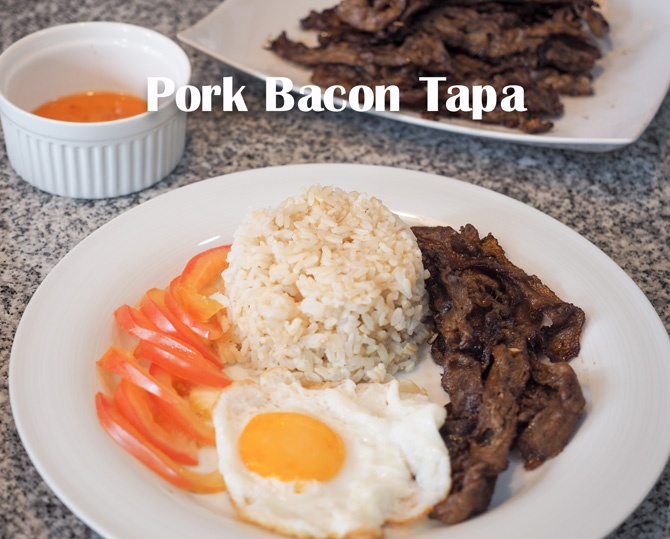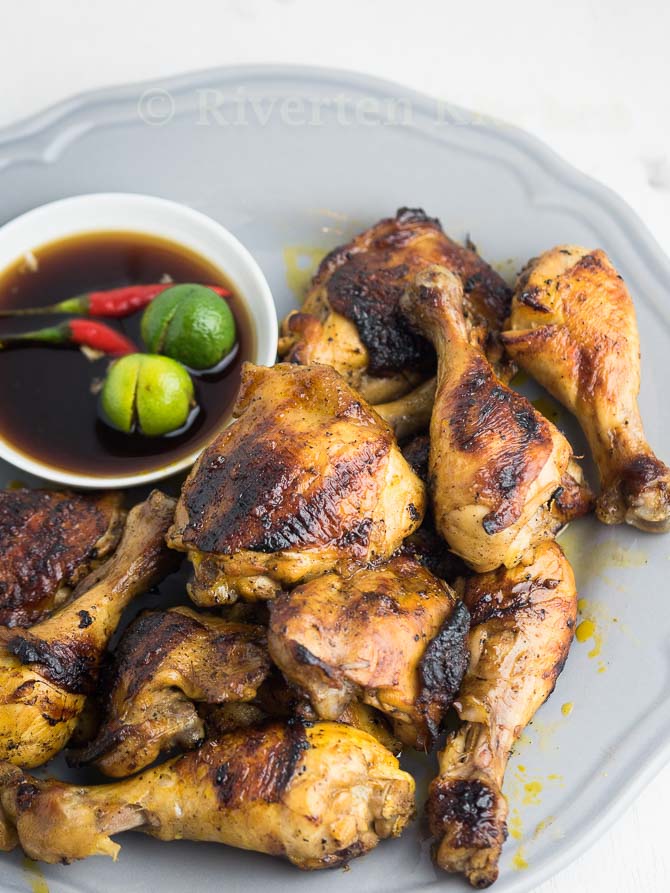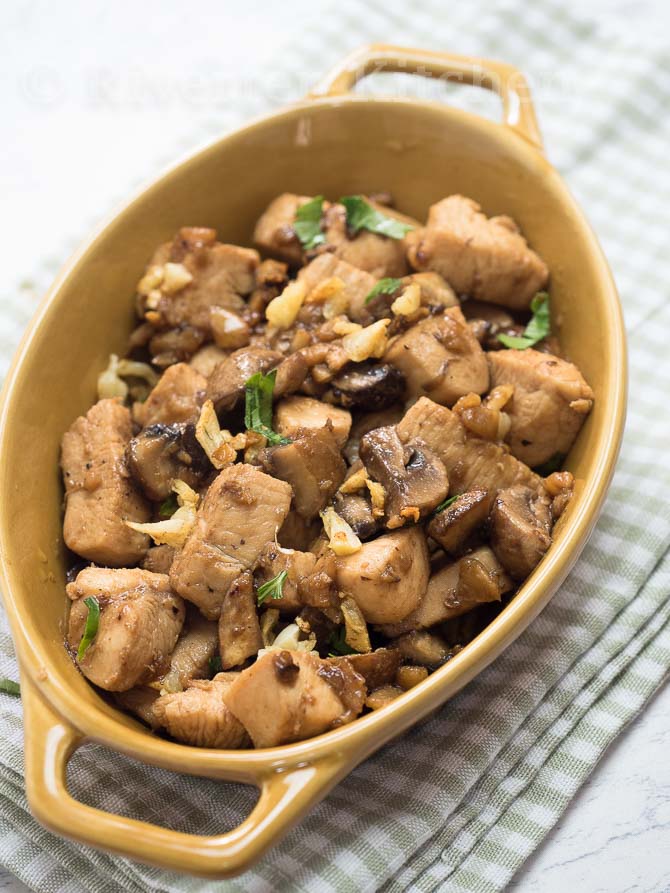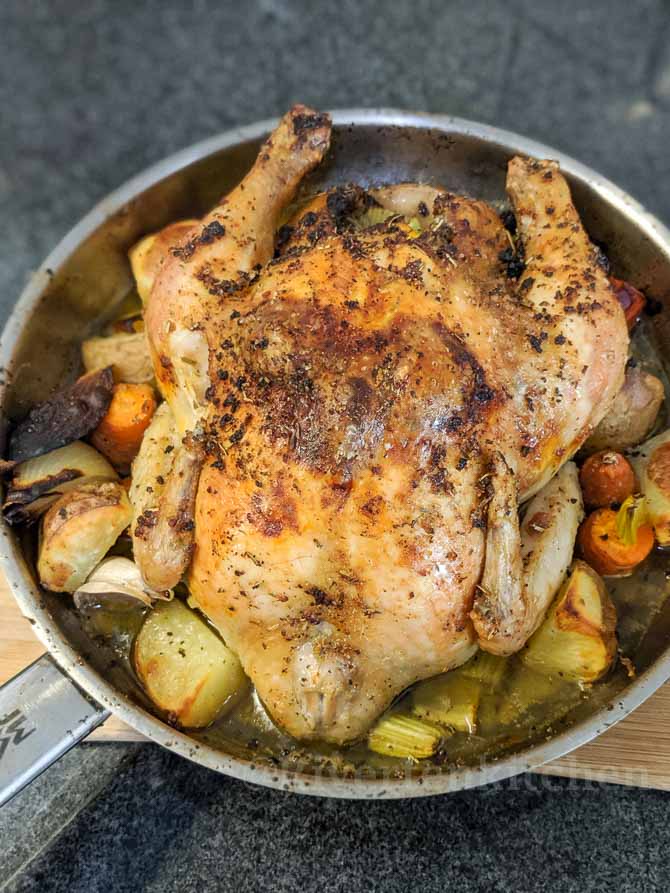A pancit canton recipe that you will love! Made with signature yellow canton noodles, perfectly tender pork, shrimp, and vegetables all slathered in the most fragrant and delicious sauce.
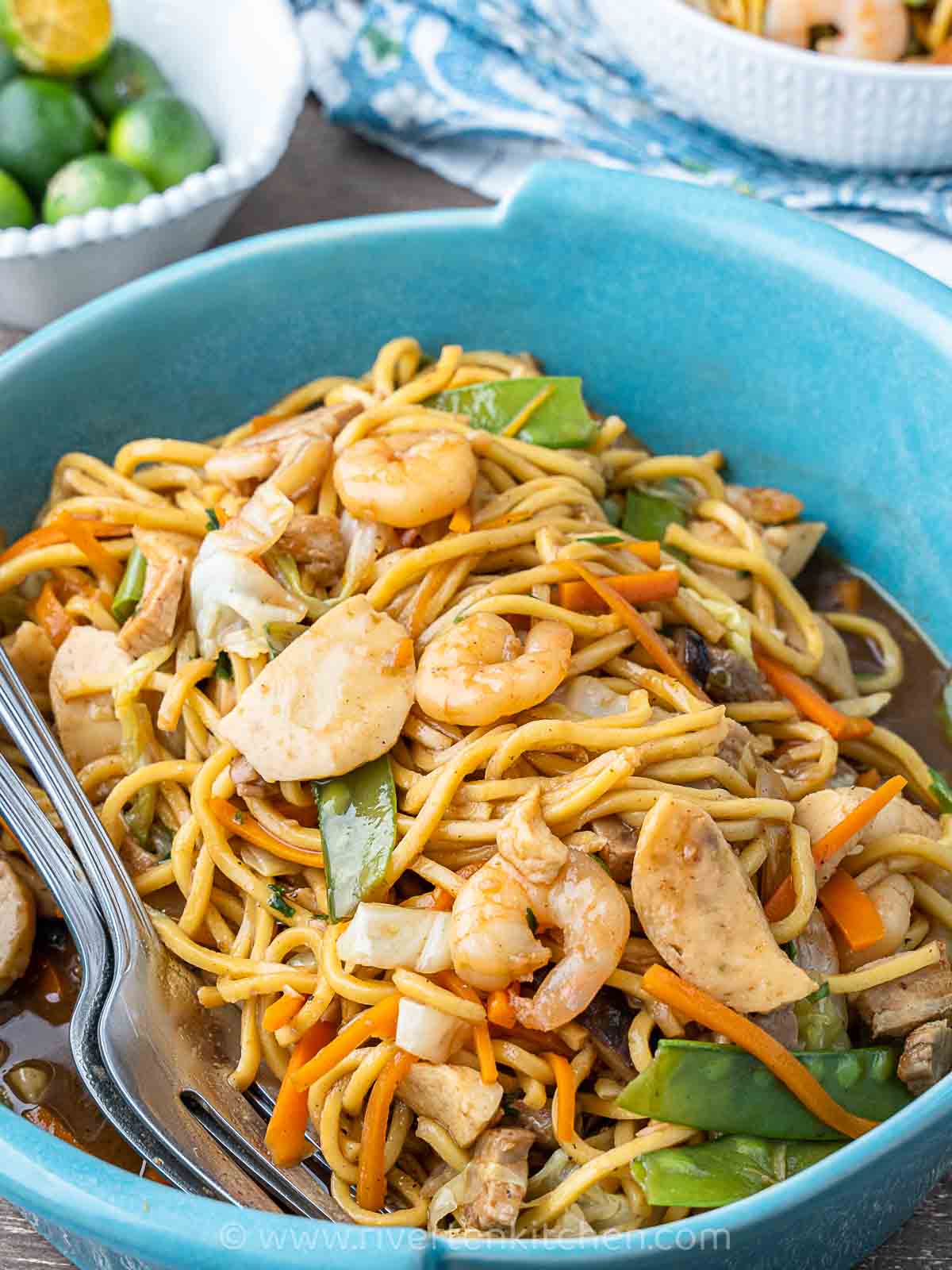
What is Pancit Canton?
A popular Filipino-Chinese noodle dish with yellow dried wheat noodles being its main ingredient. Compared to chow mein which requires par-boiling, the noodles and the sauce are cooked together in one pan. This technique helps the noodles absorb all the delicious flavors of the sauce.
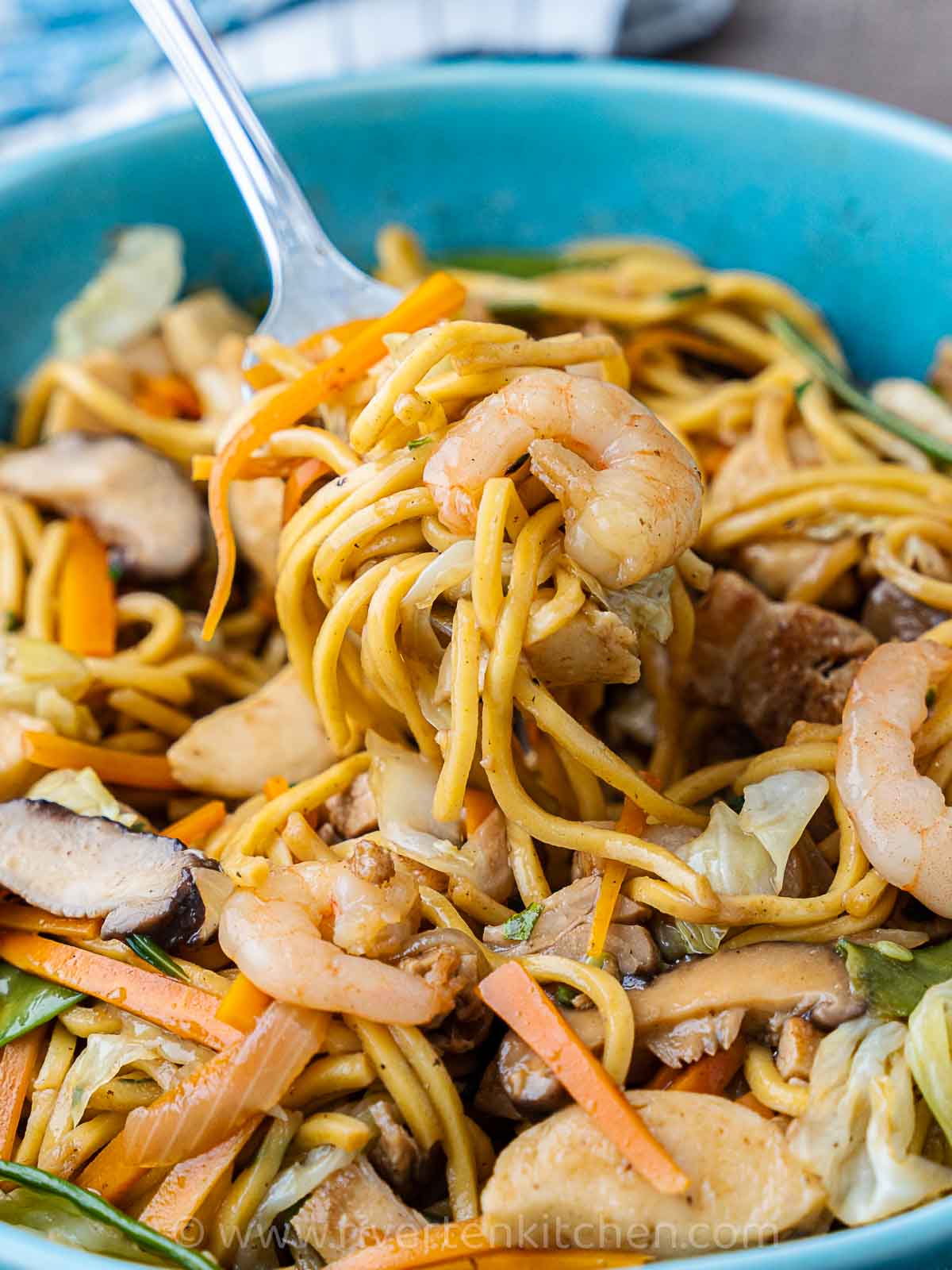
Why you’ll love this recipe
This recipe is a cross between Filipino and Chinese-style stir-fried noodles. The method of cooking follows the way of cooking dried noodles in the Philippines but the seasonings include Chinese ingredients which make it stand out from your traditional canton recipe.
You will love this recipe because of the following:
- versatile – you can make it with pork, chicken, shrimp, or even beef!
- tons of vegetable options – if you’re looking for a recipe to use up leftover vegetables then this is what you need.
- a really good sauce – thick, savory, and so flavorful! The key to making the best pancit canton. I promise you will love this!
What you need
Here are the ingredients you need to make pancit canton:
Canton Noodles
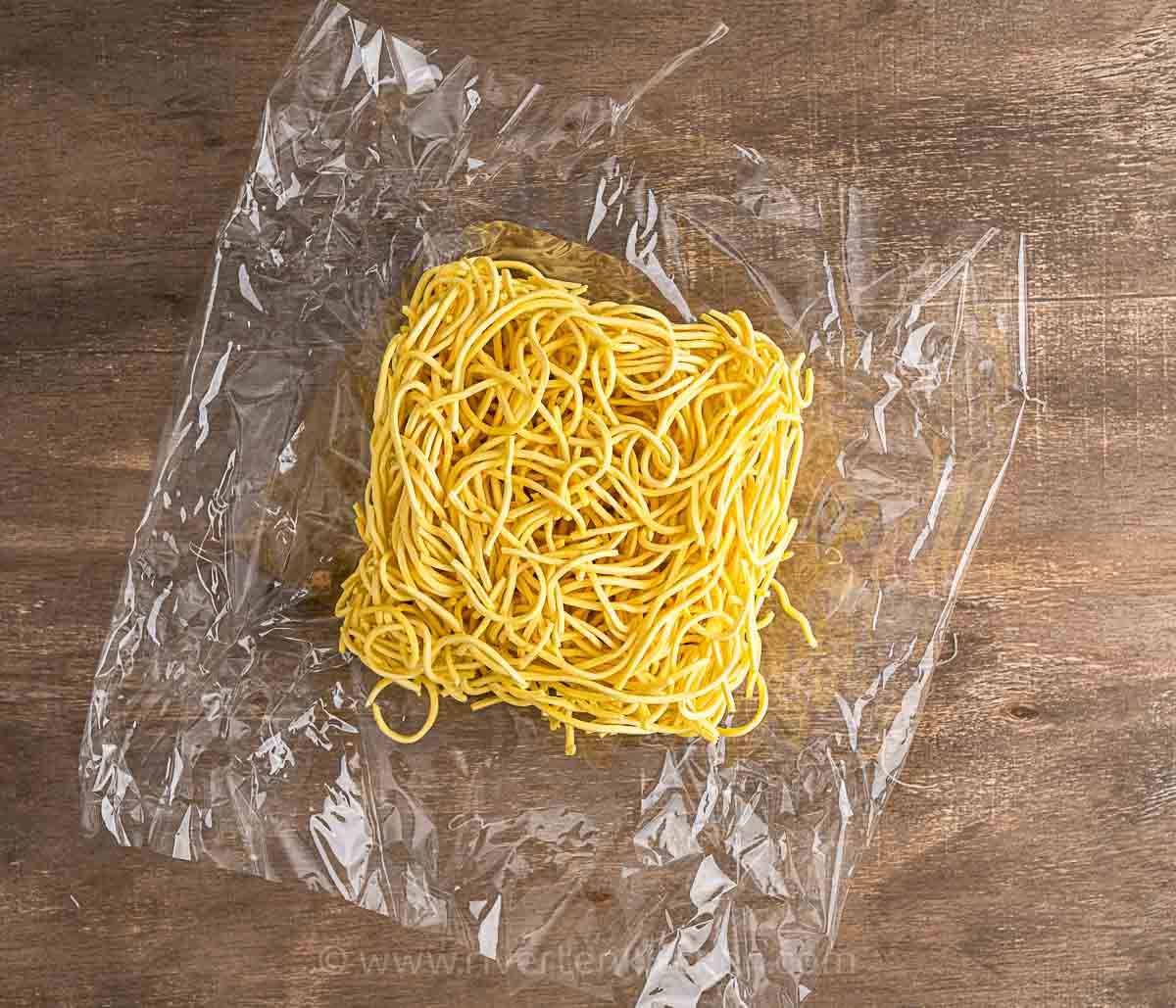
Pancit canton noodles are made of wheat flour with yellow food color. Quite similar to chow mein noodles but thicker. You can find this in most Filipino stores specifically labeled as “pancit canton”. It’s also available in most Asian stores and online like Amazon.
Pork, Chicken, or Shrimp
Use them interchangeably or use them all at the same time. Yes, you can! Pork cuts you can use are pork belly, butt, or shoulder. For chicken, use thighs for a juicier texture.
Broth
Use homemade broth or bouillon cubes for convenience. I love using pork broth from lechon kawali as it’s packed with collagen which sticks to the noodles and makes them extra slippery. Note that chicken broth can also be used as an alternative.
For the bouillon, my favorite is shrimp bouillon which adds a nice depth of flavor to the dish.
Vegetables
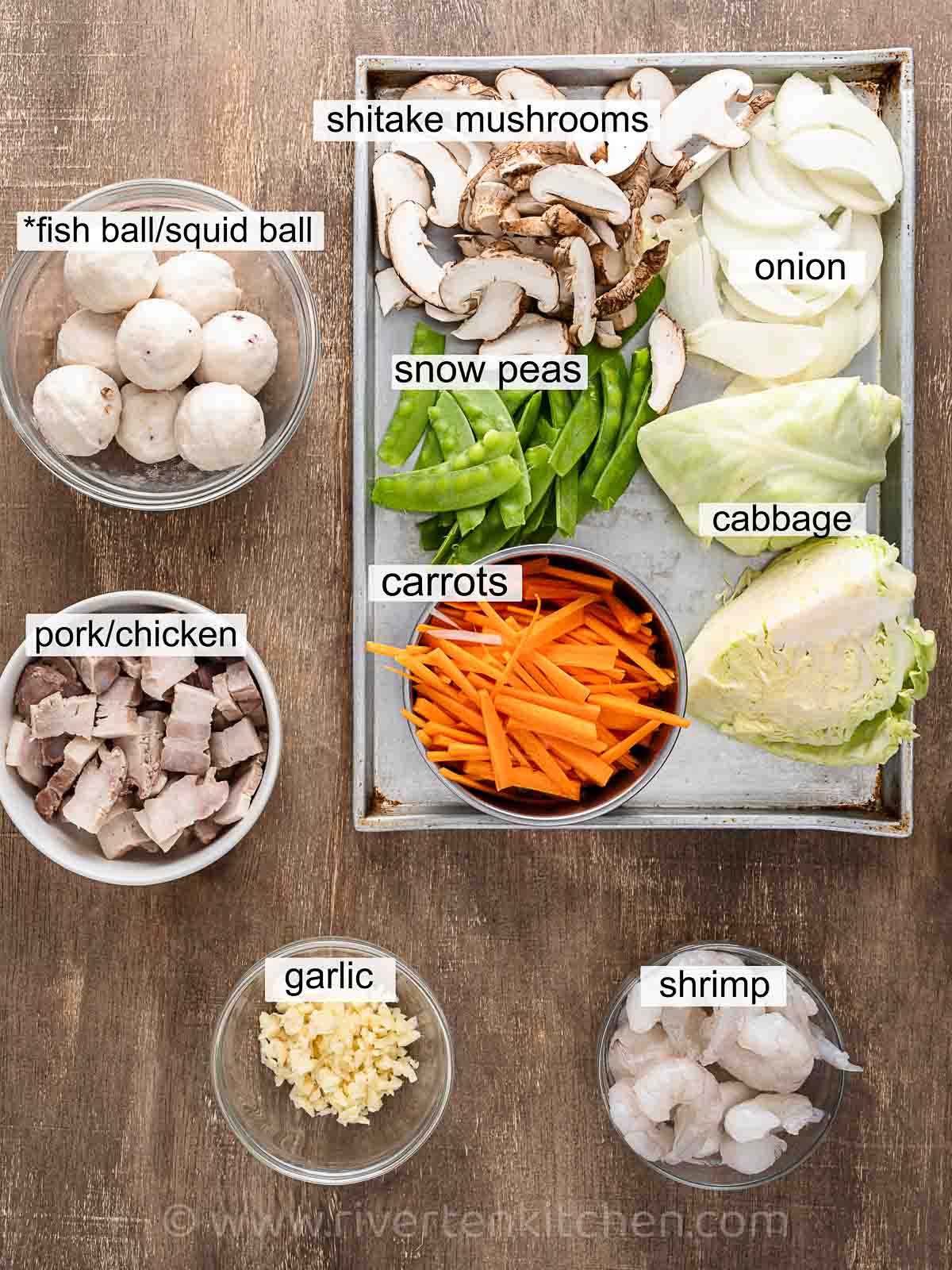
Pancit canton almost always has cabbage, carrots, and most especially snow peas which gives the dish its distinct flavor. I also love adding Chinese celery (leaf celery) and shitake mushrooms to give this Filipino noodle dish an earthy aroma.
Pancit Canton Sauce
Here’s what you need for the sauce:
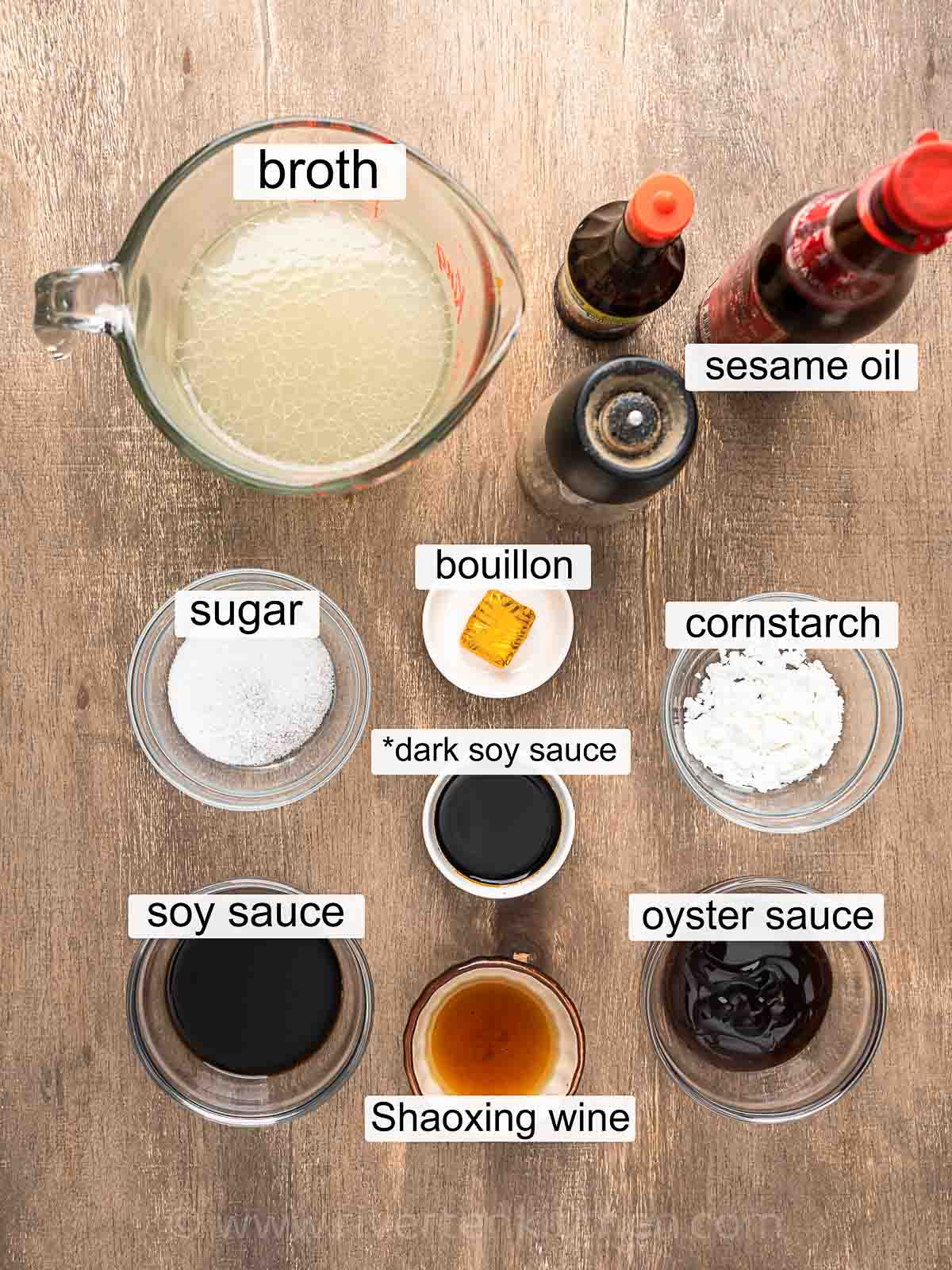
- Soy sauce – I use a combination of Filipino soy sauce and dark soy sauce. The dark soy sauce adds a nice depth of color without making the dish too salty.
- Oyster Sauce – for that signature stir-fry flavor.
- Shaoxing Wine – the key ingredient in this sauce which makes it “restaurant-style” pancit canton. I especially love the aroma and the complexity of flavor it gives to any dish.
- Sugar – to balance the salt. You don’t need much, just a teaspoon or two.
- Cornstarch – to thicken the sauce and help the flavor bind to the noodles.
- Sesame oil – added to the vegetables and noodles to give them a silky and glossy texture. It also gives the canton its signature aroma.
- Dark soy sauce – add depth of color. Optional.
How to Make the Best Pancit Canton
You can definitely use a single pan, wok, or large skillet to do it all so no need to worry about washing many dishes.
Here’s how to make it:
Part 1: Broth, Vegetables, and Toppings
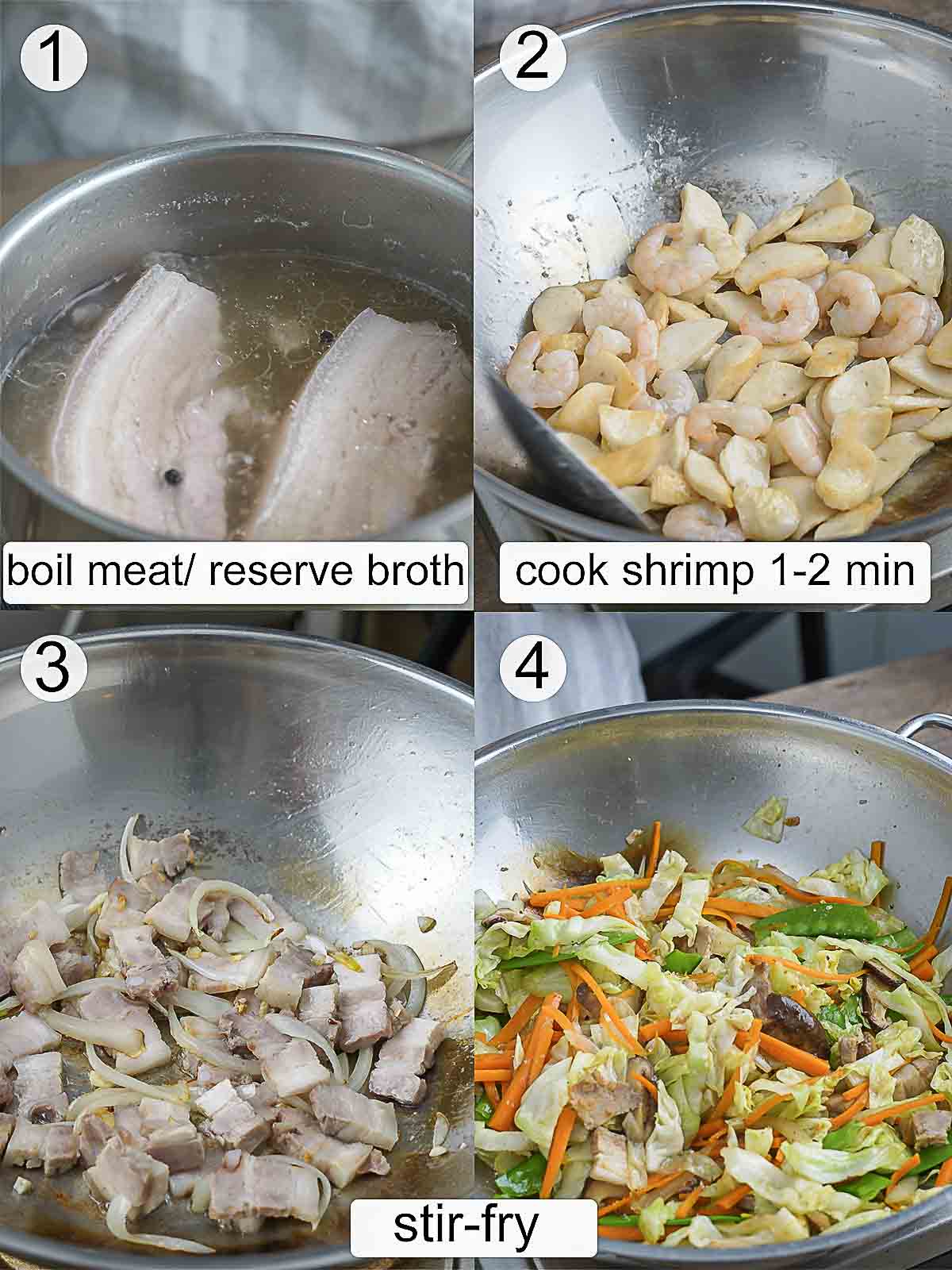
- Boil the pork until tender – I want the meat tender so I prefer cooking it separately. Reserve the broth to cook the noodles later on.
- Cook the shrimp separately to avoid overcooking it. You only need about 1 to 2 minutes then set aside.
- Stir-fry the pork and vegetables then season with the pancit canton sauce.
Part 2: Cook the noodles
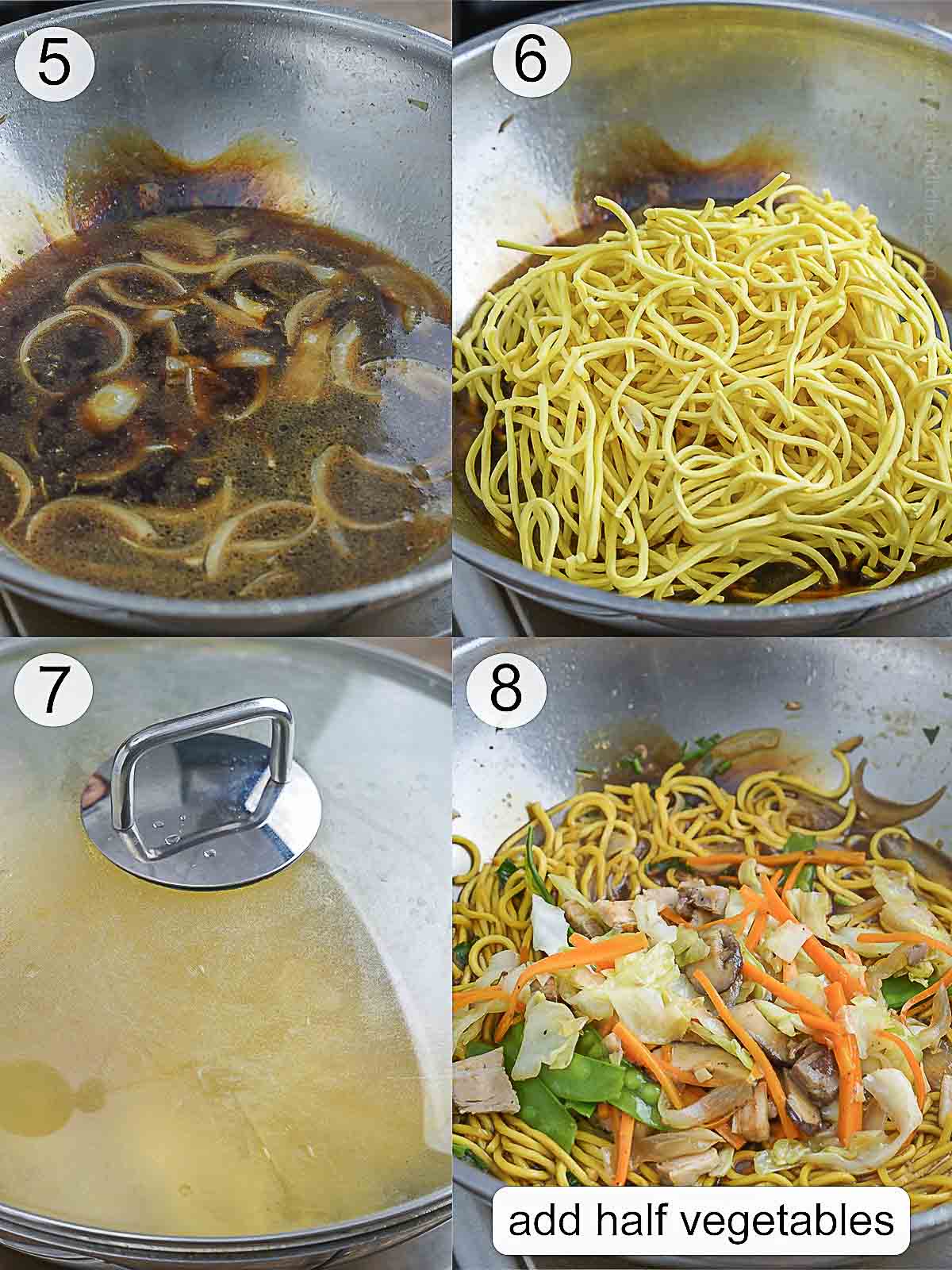
- Bring the broth to a “rapid boil” before adding the canton noodles. This helps the pieces separate from each other and prevent clumping.
- Toss, don’t stir – constant stirring can break the noodles and make them mushy. So toss the noodles using two large spoons instead of stirring.
- Taste test to check doneness – this is the only way to prevent overcooking.
- Remove from heat as soon as noodles are cooked but still firm a.k.a. AL DENTE. It will continue to cook and soak up the sauce with the residual heat.
More cooking tips
Here are my tips and tricks for making pancit canton. Nothing complicated.
Cut the vegetables into uniform sizes
To cook the veggies evenly, cut them into uniform sizes. This especially applies to carrots and celery which take longer to cook. Shred the cabbage or peel then cut into squares if you want it to stand out.
Cooked but crisp vegetables
Stir-fry with a little liquid. Use the sauce mixture made up of broth and seasonings. A couple of tablespoons is enough to lightly steam them. Say bye-bye to overcooked or undercooked vegetables!

How to Make it with Chicken or Beef
Stir-fry chicken or beef in hot oil. Add a few teaspoons of the sauce to add flavor. Remove from the heat and set aside. You can then proceed with the rest of the steps and then cook the noodles.
Other vegetables you can add
Here are other ingredients you can add to pancit canton plus tips on how to prepare them:
- Mushrooms like shitake, shimeji, portobello, button, and even wood ear mushrooms.
- Green beans – slice thinly so it cooks with the rest of the ingredients.
- Stalk Celery or Chinese celery (leaf celery) can be used interchangeably. Cook the stalk with the rest of the hard veggies then add the leaves just before the noodles finish cooking.
- Napa Cabbage – slice into stalks so it cooks quickly. Cook it together with the celery and carrots.
- Broccoli and cauliflower – slice into bite-size pieces so it cooks quickly.
- Bell peppers – use red, green, or yellow. Add together with the cabbage so it doesn’t overcook.
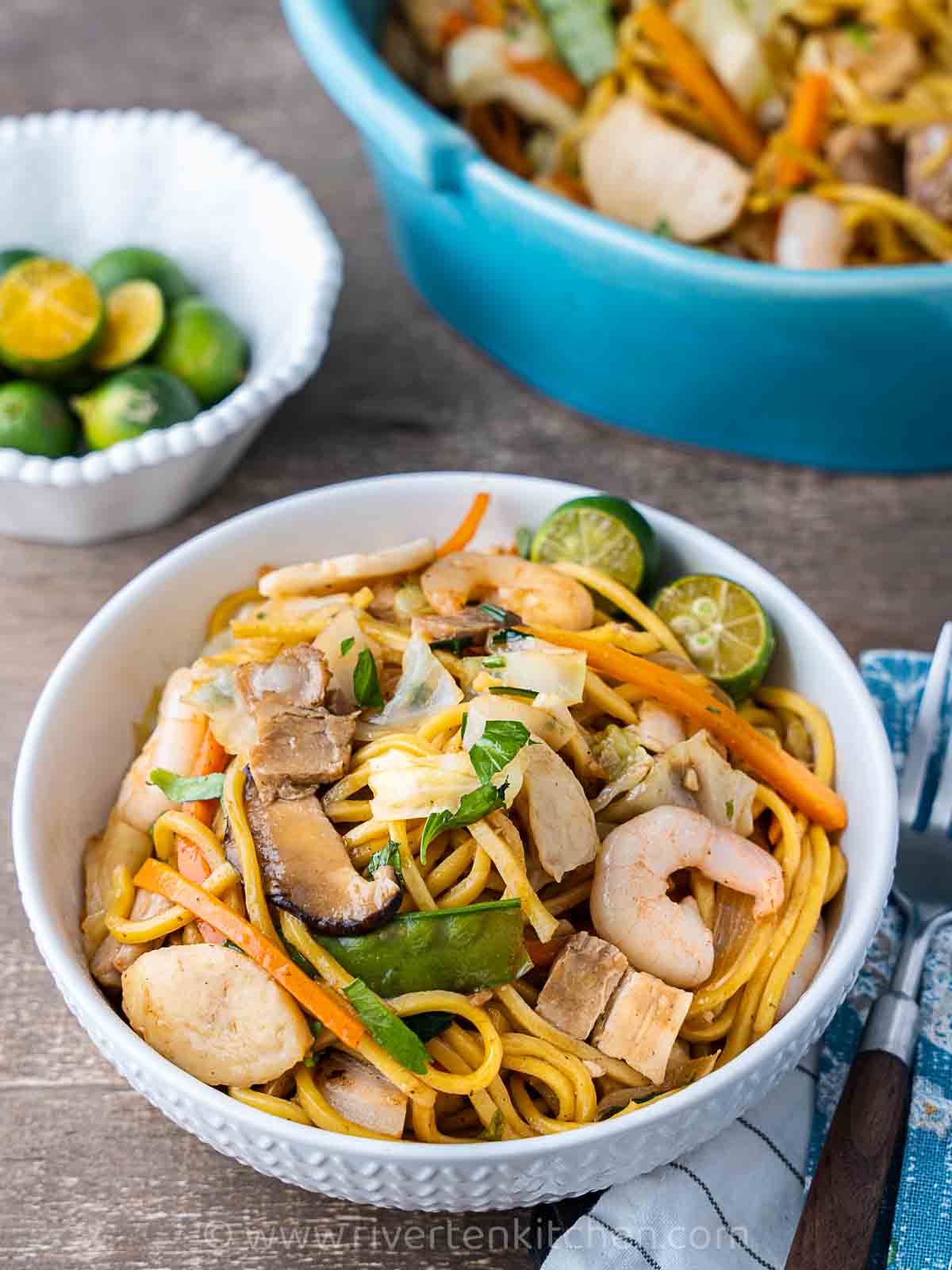
Make it extra special
If you’re serving pancit canton for Christmas, New Year, or special occasions, add a fish ball, fish cake, Chinese sausage, fried meatballs, and even squid balls. You can find all these in the hot pot section of Asian supermarkets.
Have leftover lechon kawali? Use it as a topping. I’m sure everyone will enjoy it!
Add chicken or pork liver
To prepare: Slice into serving pieces then marinate in a small amount of vinegar for 10 minutes. Rinse with water. This step lessens its strong earthy smell.
To cook: Add it straight to the boiling sauce right before adding the noodles. Cook and gently toss with the noodles.
Make it meatless
To make a meatless version of this dish, use tofu, plant-based sausages, or plant-based chicken. For the sauce, use vegetable stock and mushroom sauce as a substitute for oyster sauce.
What to Serve with Pancit Canton
Growing up, I always enjoy anything pancit with tasty bread and lumpiang shanghai. Drizzle with calamansi juice, lemon, or lime and my birthday is complete! Cheers to a long life as old folks say.
Storage and Shelf-life
Transfer the leftover pancit canton to an airtight container. Ensure that the container is tightly sealed to prevent air and moisture from entering, which can lead to staleness or spoilage.
Homemade pancit canton can last for 3 to 5 days in the refrigerator when properly stored. However, it is always recommended to use your judgment and check for any signs of spoilage, such as an off smell, mold, or unusual texture before consuming. If in doubt, it is safer to discard the noodles.
Reheat by stir-frying in a skillet with warm oil or microwave for 1 to 2 minutes.
Watch How to Make It
You might like these too
- Easy Korean Japchae (One Pan!)
- Pancit Bihon (Filipino Rice Noodles)
- Chicken Sotanghon (Glass Noodle Soup)
- Pancit Palabok Recipe (Easy!)
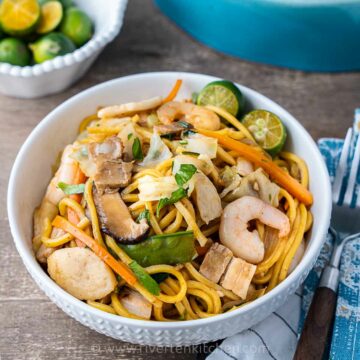
Pancit Canton Recipe
Ingredients
- 200 grams / 8 oz pork belly (note 1)
- 4 cups water
- 2 tbsp cooking oil (divided)
- 100 grams / 3.5 oz shrimp (raw, peeled and deveined)
- 100 grams /3.5 oz fish ball or fish cake (sliced, optional)
- 8 oz canton noodles (note 2)
- salt and ground black pepper (to taste)
Sauce
- 2 tbsp soy sauce
- 2 tbsp oyster sauce
- 2 tsp sugar
- 2 tbsp sesame oil
- 1 tbsp Shaoxing wine (note 3)
- 2 cups broth from the boiled meat
- 1 piece shrimp bouillon (or chicken bouillon)
- 2 tsp dark soy sauce (note 4)
- 2 tsp cornstarch (dissolved in 2 tbsp water)
Vegetables
- 4 cloves garlic (chopped, divided)
- 1 large onion (sliced, divided)
- 1 medium carrot (julienned)
- 4 pcs fresh shitake mushrooms (slice)
- ½ cabbage (shredded)
- 1 cup snow peas (chicharo) (ends trimmed, string removed)
- 2 stalks leaf celery or celery leaves (sliced diagonal strips)
Instructions
Meat and Sauce:
- Boil pork in water with 1/4 tsp salt until tender. Remove the scum as it arises. Once the meat is tender, transfer it to a chopping board. Slice it into small strips. Reserve the broth.200 grams / 8 oz pork belly, 4 cups water
- In a small bowl, mix together soy sauce, oyster sauce, sugar, sesame oil and Shaoxing wine.2 tbsp soy sauce, 2 tbsp oyster sauce, 2 tsp sugar, 1 tbsp Shaoxing wine, 2 tbsp sesame oil
Cook the shrimp
- Heat a tablespoon of oil in a wok or large pan over high heat. Add shrimp and fish balls. Season with salt and pepper, to taste. Saute until shrimp turns pink, about 1 minute. Transfer to a plate and set aside.100 grams / 3.5 oz shrimp, 100 grams /3.5 oz fish ball or fish cake
Stir-fry the vegetables
- Add more oil as needed. Add half garlic and half onion. Stir-fry until fragrant. Add cooked pork, carrots, and shitake mushrooms then stir. Cook for 2 minutes.200 grams / 8 oz pork belly, 1 medium carrot, 4 pcs fresh shitake mushrooms
- Stir in cabbage and, snow peas. Pour a splash of broth from the pork. Continue cooking until vegetables have slightly softened.1/2 cabbage, 1 cup snow peas (chicharo)
- Add 1 tablespoon of the sauce mixture then season with black pepper and salt. Taste the vegetables and add more sauce mixture as needed. Vegetables should be slightly seasoned but not bland. Continue cooking until the desired doneness is achieved. Do not overcook. Transfer to a large plate including the liquid if there's any.
Cook the noodles
- Add the remaining oil to the wok. Add remaining garlic and onion. Stir-fry until translucent. Pour 2 cups broth, remaining sauce, bouillon, and dark soy sauce. Bring to a boil. Season with ground black pepper. Do a taste test and add more oyster sauce or sugar as needed.2 cups broth from the boiled meat, 1 piece shrimp bouillon, 2 tsp dark soy sauce
- Pour cornstarch slurry, and stir. Add noodles. Simmer until the bottom side has softened. Using two large spoons flip the noodles to the other side and cook until the noodles are completely soaked in the sauce. TOSS (don't stir) every now and then until halfway cooked. Taste test noodles to check.2 tsp cornstarch, 8 oz canton noodles
- Add back half of the cooked vegetables, shrimp, and fish balls. Drizzle more sesame oil and toss to combine. Once noodles are cooked but still firm, immediately transfer them to a serving plate. Top with remaining vegetables and shrimp. Serve and enjoy!
Recipe Notes & Tips:
- Meat – use pork belly or pork butt/shoulder. For chicken, I prefer using chicken thighs for a juicier texture.
- Canton Noodles – you can find this in most Filipino stores specifically labeled as “pancit canton”. It’s also available in most Asian stores and online like Amazon. Can be substituted with chow mein noodles.
- Shaoxing wine – also known as Chinese cooking wine. Available in most Chinese grocery stores and online shops.
- Dark Soy Sauce – mainly used for color. It’s not as salty as regular soy sauce.
- To make with chicken or beef: Stir-fry chicken or beef in hot oil until browned for about 3 to 4 minutes. Add a few teaspoons of the sauce to add flavor. Remove from the heat and set aside. You can then proceed with stir-frying the vegetables and cooking the noodles.
Originally published Jan 2022. Updated with new photos. Same great recipe.
Riverten Kitchen is a participant in the Amazon Services LLC Associates Program, an affiliate advertising program designed to provide a means for sites to earn advertising fees by advertising and linking to amazon.com


